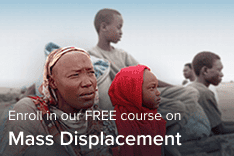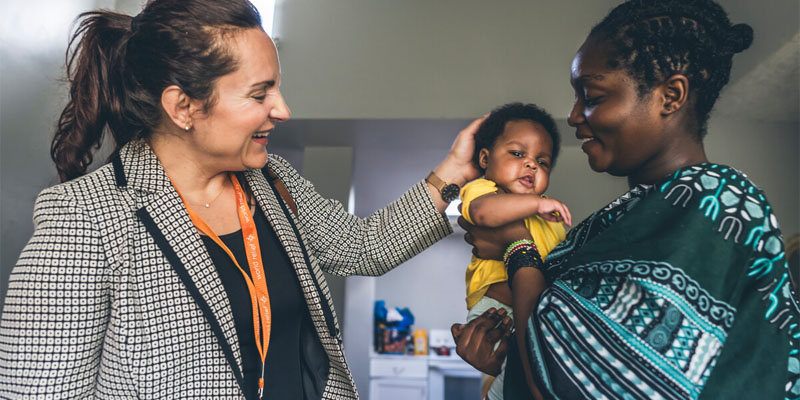
Frontline Reports is a series written entirely by program experts and local staff on the ground where World Relief works – updating on the countries, contexts, and situations, as they evolve.
I grew up in the Democratic Republic of Congo, where at the time, my parents were serving as missionaries. My best friends were girls from local families. We sang in the church choir, had sleepovers, played soccer, and did our homework together. It was a sweet and simple time, where the different color of our skin and cultural backgrounds was forgotten. In those moments, we were just kids playing games and growing up together.
As we grew older, however, things began to change. At age 13, I continued with school, while my girlfriends began staying home to take care of their siblings, and cook and clean the house. Now considered mature adults at the tender age of 13, they were expected to shoulder the majority of household responsibilities. If their parents could not afford to pay their school fees, or if there was too much to do at home, they would miss school.
Then, at eighteen, when I was preparing to move to the US for college, one of my friends looked at me and said, “You are lucky. You can do anything you want. Please, don’t forget about us.” It was in that moment that it dawned on me that while I was looking ahead to a bright future with countless opportunities; most of my friends would stay behind, lucky if they could afford to complete secondary school in a war-torn, poverty-stricken country.
The Challenge
Today, there are over 1.1 billion girls in the world—girls with hopes, goals and dreams for their future. And while every girl deserves equal opportunity to build her future, there are still significant challenges and barriers that stand in the way for girls all over the world. Conflict, poverty, access to education, cultural and religious norms, and social conditions are all factors that today limit girls’ access to equal opportunity.
A recent report by UNESCO found there are 31 million girls of primary school age who are not in school [1], and adolescent girls in conflict zones and 90% more likely to drop out of school as compared to girls in conflict-free countries [2], which has significant impacts for their futures. Additionally, as families are displaced, the risk of sexual violence against girls and women increases drastically and families are forced to rely on negative coping mechanisms like early marriage and child labor.
Poverty is also a significant barrier for girls, as their educational future is often dictated by the economic position of the family. When families cannot afford to send both children to school, they will almost always choose to send the male child, as girls are seen as less valuable than boys. This also leaves girls at increased risk for early child marriage. Many cultures today still believe that a girl is ready for marriage upon reaching puberty, meaning girls are dropping out of school to get married. Each year, over 12 million girls are married before they reach 18 years old, compromising their future prospects for both work and financial security. Oftentimes, girls are married off to older men so that the bride price can support her family. Isolated and with limited freedom, these girls are deprived of their rights to health, education and safety.
The Opportunity
“So God created mankind in his own image, in the image of God he created them; male and female he created them.” (Gen 1:27, NIV).
At World Relief, we believe that girls and women are made in the image of God. By working alongside local churches and community members, we work to empower girls around the world as they strive to build bolder, brighter futures. Here are some of the ways in which we are responding:



In Malawi, a girl is 50 times more likely to be married before age 18 than to enter university by age 18. 42% of girls have experience physical violence in childhood, and 22% of girls have experienced sexual violence in childhood [3]. Since 2016, World Relief has implemented girl’s groups reaching over 4,000 adolescent girls and young women in Malawi. In partnership with UNICEF, we’ve formed groups for adolescent mothers to learn more about early childhood development, nutrition, protection from HIV/AIDS and other relevant subjects. In an effort to prevent school dropout, we also bring together additional groups of girls aged 13-17 years old who provide support and encouragement to one another as they learn essential life skills during a 10-month curriculum.
In South Sudan, the world’s newest nation, millions struggle as a result of extreme poverty and poor access to food and health care. Civil war and escalating rates of violence have caused many humanitarian organizations to withdraw from the fledgling nation. Here, World Relief is reaching children whose schooling has been interrupted by conflict through our Education in Emergencies programming. This program supports primary schools to reopen, as well as providing child friendly spaces that offer primary school lessons in the absence of formal schools. Children receive school supplies to support their lessons, and teachers receive capacity-building and professional development training. To date, World Relief has enrolled 23,605 children, about 37% of whom are girls, and supported 315 teachers.
In Jordan,World Relief has developed a gender equality through sports program, using soccer as a tool to empower women and girls in vulnerable communities. In more traditional areas of Jordan, girls have very limited opportunities to exercise or play sports. Our sports program has fostered self-esteem, empowerment and self-advocacy for girls from all backgrounds by challenging harmful gender norms and providing opportunities for leadership. The program has also brought both Jordanians and Syrian refugees together and provided an avenue for dialogue and violence prevention. Since 2016, nearly 300 girls have been reached through the soccer program. The change has been incredible. Teachers have transformed into coaches, students have transformed into athletes, and loosely held hopes have transformed into bold and vibrant dreams.
Call to Action
Today, on International Day of the Girl Child, I am reminded of the words of Malala Yousfzai (Pakistani education activist) who said, “We cannot all succeed when half of us are held back.” So let us strive forward and continue to be advocates and champions for girls. Let us bring gender injustice and inequality to light so that girls may be protected, celebrated for their gifts and talents, and given equal opportunities to pursue their dreams. And let us imagine the impact across nations when we invest in young girls, realizing their unique value as girls who have been beautifully and wonderfully made in the image of God.
[1] UNESCO: Girls’ education – the facts, October 2013
[2] Education for All Global Monitoring Report, 2015
[3] Together for girls: Malawi

Laura Mouanoutoua joined World Relief in 2015 and currently serves as Program Officer for Disaster Response and Middle East programs. Laura grew up in the DR Congo, where her parents served as missionaries, and has witnessed first-hand the difficulties that internally displaced peoples and refugees face. Laura is passionate about engaging against social injustices, with a strong spiritual conviction and desire to work with the church at large for the support and success of refugee and conflict-affected populations.


